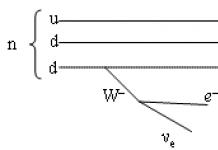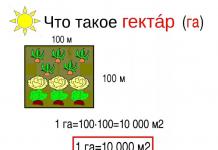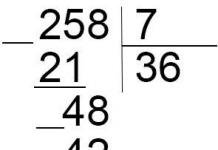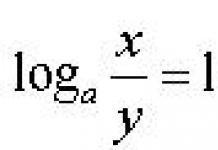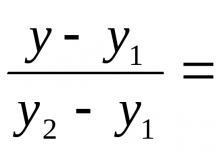The graph of a quadratic function is a parabola. The solutions (roots) of the quadratic equation are the points of intersection of the parabola with the abscissa axis. If the parabola described quadratic function, does not intersect with the abscissa axis, the equation has no real roots. If a parabola intersects the abscissa at one point (the vertex of the parabola), the equation has one real root (it is also said that the equation has two coinciding roots). If the parabola crosses the abscissa axis at two points, the equation has two real roots.
If the coefficient a positive, the branches of the parabola are directed upwards; if negative, the branches of the parabola are directed downward. If the coefficient b is positive, then the vertex of the parabola lies in the left half-plane, if negative, in the right half-plane.
Derivation of a formula for solving a quadratic equation
The formula for solving a quadratic equation can be obtained as follows
a x 2 + b x + c = 0a x 2 + b x = - c
Multiply the equation by 4 a
4a 2 x 2 + 4 ab x = -4 ac
4a 2 x 2 + 4 ab x + b 2 = -4ac + b 2
(2a x + b) 2 = b 2 -4ac
2a x + b= ± $ \ sqrt (b ^ 2-4 a c) $
Finding the roots of a quadratic equation
A quadratic equation with real coefficients can have from 0 to 2 real roots, depending on the value of the discriminant D = b 2 − 4ac:
- for D> 0 there are two roots, and they are calculated by the formula
- for D = 0, there is one root (two equal or coinciding roots), of multiplicity 2:
In modern society, the ability to perform actions with equations containing a variable squared can be useful in many areas of activity and is widely used in practice in scientific and technical developments. This is evidenced by the design of sea and river vessels, airplanes and missiles. With the help of such calculations, the trajectories of movement of a wide variety of bodies, including space objects, are determined. Examples with solution quadratic equations find application not only in economic forecasting, in the design and construction of buildings, but also in the most ordinary everyday circumstances. They may be needed on camping trips, at sports events, in stores when shopping, and in other very common situations.
Let's break the expression into its constituent factors
The degree of an equation is determined by the maximum value of the degree of the variable that the given expression contains. If it is equal to 2, then such an equation is called square.
If we use the language of formulas, then these expressions, no matter how they look, can always be reduced to the form when the left side of the expression consists of three terms. Among them: ax 2 (that is, a variable squared with its coefficient), bx (an unknown without a square with its coefficient) and c (a free component, that is, an ordinary number). All this on the right side equals 0. In the case when a similar polynomial is missing one of its constituent terms, with the exception of ax 2, it is called an incomplete quadratic equation. Examples with the solution of such problems, the value of variables in which is easy to find, should be considered first.
If the expression looks in such a way that there are two terms on the right side of the expression, more precisely ax 2 and bx, it is easiest to find x by placing the variable outside the brackets. Now our equation will look like this: x (ax + b). Further, it becomes obvious that either x = 0, or the problem is reduced to finding a variable from the following expression: ax + b = 0. This is dictated by one of the properties of multiplication. The rule is that the product of two factors results in 0 only if one of them is equal to zero.
Example
x = 0 or 8x - 3 = 0
As a result, we get two roots of the equation: 0 and 0.375.
Equations of this kind can describe the movement of bodies under the action of gravity, which began to move from a certain point taken as the origin. Here the mathematical notation takes the following form: y = v 0 t + gt 2/2. Substituting the necessary values, equating the right side to 0 and finding possible unknowns, you can find out the time elapsing from the moment the body rises to the moment it falls, as well as many other quantities. But we'll talk about this later.

Factoring an Expression
The rule described above makes it possible to solve these problems in more complex cases. Let's consider examples with the solution of quadratic equations of this type.
X 2 - 33x + 200 = 0
This square trinomial is complete. First, let's transform the expression and factor it. There are two of them: (x-8) and (x-25) = 0. As a result, we have two roots 8 and 25.
Examples with the solution of quadratic equations in grade 9 allow this method to find a variable in expressions not only of the second, but even of the third and fourth orders.
For example: 2x 3 + 2x 2 - 18x - 18 = 0. When factoring the right side into factors with a variable, there are three of them, that is, (x + 1), (x-3) and (x + 3).
As a result, it becomes obvious that this equation has three roots: -3; -one; 3.
Extraction of the square root
Another case incomplete equation of the second order is an expression, in the language of letters, represented in such a way that the right-hand side is constructed from the components ax 2 and c. Here, to obtain the value of the variable, the free term is transferred to the right side, and after that, from both sides of the equality, is extracted Square root... It should be noted that in this case, there are usually two roots of the equation. The only exceptions are equalities that do not contain the term c at all, where the variable is equal to zero, as well as variants of expressions when the right-hand side turns out to be negative. In the latter case, there are no solutions at all, since the above actions cannot be performed with roots. Examples of solutions to quadratic equations of this type should be considered.
In this case, the roots of the equation will be the numbers -4 and 4.
Calculation of the area of the land plot
The need for this kind of calculations appeared in ancient times, because the development of mathematics in many respects in those distant times was due to the need to determine with the greatest accuracy the areas and perimeters of land plots.

Examples with the solution of quadratic equations, compiled on the basis of problems of this kind, should be considered by us.
So, let's say there is a rectangular piece of land, the length of which is 16 meters longer than the width. Find the length, width and perimeter of the site if it is known that its area is 612 m 2.
Getting down to business, let's first draw up the necessary equation. Let's denote by x the width of the section, then its length will be (x + 16). It follows from what has been written that the area is determined by the expression x (x + 16), which, according to the condition of our problem, is 612. This means that x (x + 16) = 612.
The solution of complete quadratic equations, and this expression is just that, cannot be done in the same way. Why? Although the left side of it still contains two factors, the product does not equal 0 at all, so other methods apply here.
Discriminant
First of all, we will make the necessary transformations, then the appearance of this expression will look like this: x 2 + 16x - 612 = 0. This means that we have received an expression in the form corresponding to the previously indicated standard, where a = 1, b = 16, c = -612.
This can be an example of solving quadratic equations through the discriminant. Here the necessary calculations are made according to the scheme: D = b 2 - 4ac. This auxiliary quantity not only makes it possible to find the required quantities in the second-order equation, it determines the number of possible options. If D> 0, there are two of them; for D = 0 there is one root. If D<0, никаких шансов для решения у уравнения вообще не имеется.
About roots and their formula
In our case, the discriminant is: 256 - 4 (-612) = 2704. This indicates that our problem has an answer. If you know, k, the solution of quadratic equations must be continued using the formula below. It allows you to calculate the roots.

This means that in the presented case: x 1 = 18, x 2 = -34. The second option in this dilemma cannot be a solution, because the dimensions of the land plot cannot be measured in negative values, so x (that is, the width of the plot) is 18 m.From here we calculate the length: 18 + 16 = 34, and the perimeter 2 (34+ 18) = 104 (m 2).
Examples and tasks
We continue to study quadratic equations. Examples and a detailed solution to several of them will be given below.
1) 15x 2 + 20x + 5 = 12x 2 + 27x + 1
We transfer everything to the left side of the equality, make a transformation, that is, we get the form of the equation, which is usually called standard, and equate it to zero.
15x 2 + 20x + 5 - 12x 2 - 27x - 1 = 0
Adding similar ones, we define the discriminant: D = 49 - 48 = 1. This means that our equation will have two roots. Let's calculate them according to the above formula, which means that the first of them will be equal to 4/3, and the second 1.
2) Now we will reveal the riddles of a different kind.
Let us find out if there are any roots here at all x 2 - 4x + 5 = 1? To obtain an exhaustive answer, let us bring the polynomial to the appropriate familiar form and calculate the discriminant. In this example, the solution of the quadratic equation is not necessary, because the essence of the problem is not at all in this. In this case, D = 16 - 20 = -4, which means that there really are no roots.
Vieta's theorem
It is convenient to solve quadratic equations using the above formulas and the discriminant, when the square root is extracted from the value of the latter. But this is not always the case. However, there are many ways to get the values of variables in this case. Example: solving quadratic equations by Vieta's theorem. She is named after a man who lived in 16th century France and made a brilliant career thanks to his mathematical talent and connections at court. His portrait can be seen in the article.

The pattern noticed by the famous Frenchman was as follows. He proved that the roots of the equation in the sum are numerically equal to -p = b / a, and their product corresponds to q = c / a.
Now let's look at specific tasks.
3x 2 + 21x - 54 = 0
For simplicity, let's transform the expression:
x 2 + 7x - 18 = 0
We will use Vieta's theorem, this will give us the following: the sum of the roots is -7, and their product is -18. From this we get that the roots of the equation are the numbers -9 and 2. Having made a check, we will make sure that these values of the variables really fit into the expression.
Parabola graph and equation
The concepts of a quadratic function and quadratic equations are closely related. Examples of this have already been given earlier. Now let's look at some of the math riddles in a little more detail. Any equation of the described type can be visualized. Such a relationship, drawn in the form of a graph, is called a parabola. Its various types are shown in the figure below.

Any parabola has a vertex, that is, a point from which its branches emerge. If a> 0, they go high to infinity, and when a<0, они рисуются вниз. Простейшим примером подобной зависимости является функция y = x 2 . В данном случае в уравнении x 2 =0 неизвестное может принимать только одно значение, то есть х=0, а значит существует только один корень. Это неудивительно, ведь здесь D=0, потому что a=1, b=0, c=0. Выходит формула корней (точнее одного корня) квадратного уравнения запишется так: x = -b/2a.
Visual representations of functions help to solve any equations, including quadratic ones. This method is called graphical. And the value of the variable x is the abscissa coordinate at the points where the graph line intersects with 0x. The coordinates of the vertex can be found by the just given formula x 0 = -b / 2a. And, substituting the resulting value into the original equation of the function, you can find out y 0, that is, the second coordinate of the vertex of the parabola, belonging to the ordinate axis.
The intersection of the branches of the parabola with the abscissa axis
There are a lot of examples with the solution of quadratic equations, but there are also general patterns. Let's consider them. It is clear that the intersection of the graph with the 0x axis for a> 0 is possible only if y 0 takes negative values. And for a<0 координата у 0 должна быть положительна. Для указанных вариантов D>0. Otherwise, D<0. А когда D=0, вершина параболы расположена непосредственно на оси 0х.
The roots can also be determined from the parabola graph. The converse is also true. That is, if it is not easy to get a visual image of a quadratic function, you can equate the right side of the expression to 0 and solve the resulting equation. And knowing the points of intersection with the 0x axis, it is easier to build a graph.
From the history
With the help of equations containing a variable squared, in the old days they not only made mathematical calculations and determined the areas of geometric shapes. The ancients needed such calculations for grandiose discoveries in the field of physics and astronomy, as well as for making astrological forecasts.

As modern scientists assume, the inhabitants of Babylon were among the first to solve quadratic equations. It happened four centuries before our era. Of course, their calculations were fundamentally different from those currently accepted and turned out to be much more primitive. For example, the Mesopotamian mathematicians had no idea about the existence of negative numbers. They were also unfamiliar with other subtleties from those that any schoolchild of our time knows.
Perhaps even earlier than the scientists of Babylon, the sage from India Baudhayama took up the solution of quadratic equations. It happened about eight centuries before the advent of the era of Christ. True, the equations of the second order, the methods of solving which he gave, were the simplest. In addition to him, Chinese mathematicians were also interested in similar questions in the old days. In Europe, quadratic equations began to be solved only at the beginning of the 13th century, but later they were used in their works by such great scientists as Newton, Descartes and many others.
This topic may seem complicated at first due to the many difficult formulas. Not only do the quadratic equations themselves have long records, but also the roots are found through the discriminant. There are three new formulas in total. It's not easy to remember. This is possible only after frequent solution of such equations. Then all the formulas will be remembered by themselves.
General view of the quadratic equation
Here, their explicit recording is proposed, when the highest degree is recorded first, and then in descending order. There are often situations when the terms are out of order. Then it is better to rewrite the equation in decreasing order of the degree of the variable.
Let us introduce the notation. They are presented in the table below.
If we accept these designations, all quadratic equations are reduced to the following record.

Moreover, the coefficient a ≠ 0. Let this formula be denoted by number one.
When the equation is given, it is not clear how many roots there will be in the answer. Because one of three options is always possible:
- there will be two roots in the solution;
- the answer is one number;
- the equation will have no roots at all.
And until the decision is not brought to the end, it is difficult to understand which of the options will fall out in a particular case.
Types of records of quadratic equations
Tasks may contain their different records. They will not always look like a general quadratic equation. Sometimes it will lack some terms. What was written above is a complete equation. If you remove the second or third term in it, you get something different. These records are also called quadratic equations, only incomplete.
Moreover, only the terms in which the coefficients "b" and "c" can disappear. The number "a" cannot be zero under any circumstances. Because in this case, the formula turns into a linear equation. Formulas for an incomplete form of equations will be as follows:
So, there are only two types, besides the complete ones, there are also incomplete quadratic equations. Let the first formula be number two and the second number three.
Discriminant and dependence of the number of roots on its value
You need to know this number in order to calculate the roots of the equation. It can always be calculated, no matter what the formula for the quadratic equation. In order to calculate the discriminant, you need to use the equality written below, which will have the number four.
After substituting the values of the coefficients into this formula, you can get numbers with different signs. If the answer is yes, then the answer to the equation will be two different roots. With a negative number, the roots of the quadratic equation will be absent. If it is equal to zero, the answer will be one.
How is a complete quadratic equation solved?
In fact, consideration of this issue has already begun. Because first you need to find the discriminant. After it has been found that there are roots of the quadratic equation, and their number is known, you need to use the formulas for the variables. If there are two roots, then you need to apply the following formula.

Since it contains the “±” sign, there will be two values. The square root expression is the discriminant. Therefore, the formula can be rewritten in a different way.
Formula number five. The same record shows that if the discriminant is zero, then both roots will take the same values.
If the solution of quadratic equations has not yet been worked out, then it is better to write down the values of all coefficients before applying the discriminant and variable formulas. Later this moment will not cause difficulties. But at the very beginning, there is confusion.

How is an incomplete quadratic equation solved?
Everything is much simpler here. There is even no need for additional formulas. And you will not need those that have already been recorded for the discriminant and the unknown.
First, consider the incomplete equation number two. In this equality, it is supposed to take the unknown quantity out of the bracket and solve the linear equation, which remains in the brackets. The answer will have two roots. The first one is necessarily equal to zero, because there is a factor consisting of the variable itself. The second is obtained when solving a linear equation.
Incomplete equation number three is solved by transferring the number from the left side of the equation to the right. Then you need to divide by the factor in front of the unknown. All that remains is to extract the square root and remember to write it down twice with opposite signs.

Next, some actions are written to help you learn how to solve all kinds of equations, which turn into quadratic equations. They will help the student to avoid careless mistakes. These shortcomings are the reason for poor grades when studying the extensive topic "Quadratic Equations (Grade 8)". Subsequently, these actions will not need to be constantly performed. Because a stable skill will appear.
- First, you need to write the equation in standard form. That is, first the term with the highest degree of the variable, and then - without the degree and the last - just a number.
- If a minus appears in front of the coefficient "a", then it can complicate the work for a beginner to study quadratic equations. It is better to get rid of it. For this purpose, all equality must be multiplied by "-1". This means that all the terms will change their sign to the opposite.
- In the same way, it is recommended to get rid of fractions. Simply multiply the equation by the appropriate factor to cancel out the denominators.

Examples of
It is required to solve the following quadratic equations:
x 2 - 7x = 0;
15 - 2x - x 2 = 0;
x 2 + 8 + 3x = 0;
12x + x 2 + 36 = 0;
(x + 1) 2 + x + 1 = (x + 1) (x + 2).
The first equation: x 2 - 7x = 0. It is incomplete, therefore it is solved as described for the formula number two.
After leaving the brackets, it turns out: x (x - 7) = 0.
The first root takes the value: x 1 = 0. The second will be found from the linear equation: x - 7 = 0. It is easy to see that x 2 = 7.
Second equation: 5x 2 + 30 = 0. Again incomplete. Only it is solved as described for the third formula.
After transferring 30 to the right side of the equality: 5x 2 = 30. Now you need to divide by 5. It turns out: x 2 = 6. The answers will be the numbers: x 1 = √6, x 2 = - √6.
The third equation: 15 - 2x - x 2 = 0. Hereinafter, the solution of quadratic equations will begin by rewriting them in the standard form: - x 2 - 2x + 15 = 0. Now it's time to use the second useful advice and multiply everything by minus one ... It turns out x 2 + 2x - 15 = 0. According to the fourth formula, you need to calculate the discriminant: D = 2 2 - 4 * (- 15) = 4 + 60 = 64. It is a positive number. From what was said above, it turns out that the equation has two roots. They need to be calculated using the fifth formula. It turns out that x = (-2 ± √64) / 2 = (-2 ± 8) / 2. Then x 1 = 3, x 2 = - 5.
The fourth equation x 2 + 8 + 3x = 0 is transformed into this: x 2 + 3x + 8 = 0. Its discriminant is equal to this value: -23. Since this number is negative, the answer to this task will be the following entry: "There are no roots."
The fifth equation 12x + x 2 + 36 = 0 should be rewritten as follows: x 2 + 12x + 36 = 0. After applying the formula for the discriminant, the number zero is obtained. This means that it will have one root, namely: x = -12 / (2 * 1) = -6.
The sixth equation (x + 1) 2 + x + 1 = (x + 1) (x + 2) requires transformations, which consist in the fact that you need to bring similar terms, before opening the brackets. In place of the first, there will be such an expression: x 2 + 2x + 1. After the equality, this record will appear: x 2 + 3x + 2. After such terms are counted, the equation will take the form: x 2 - x = 0. It turned into incomplete ... Something similar to it has already been considered a little higher. The roots of this will be the numbers 0 and 1.
Quadratic equations. Discriminant. Solution, examples.
Attention!
There are additional
materials in Special Section 555.
For those who are very "not very ..."
And for those who are "very even ...")
Types of quadratic equations
What is a Quadratic Equation? What does it look like? In term quadratic equation the key word is "square". It means that in the equation necessarily there must be an x squared. In addition to him, the equation may (or may not be!) Just x (in the first power) and just a number (free member). And there should be no x's to a degree greater than two.
Mathematically speaking, a quadratic equation is an equation of the form:
Here a, b and c- some numbers. b and c- absolutely any, but a- anything other than zero. For instance:
![]()
Here a =1; b = 3; c = -4
![]()
Here a =2; b = -0,5; c = 2,2
![]()
Here a =-3; b = 6; c = -18
Well, you get the idea ...
In these quadratic equations on the left there is full set members. X squared with coefficient a, x to the first power with a coefficient b and free term with.
Such quadratic equations are called full.
And if b= 0, what do we get? We have X will disappear in the first degree. This happens from multiplication by zero.) It turns out, for example:
5x 2 -25 = 0,
2x 2 -6x = 0,
-x 2 + 4x = 0
Etc. And if both coefficients, b and c are equal to zero, then everything is even simpler:
2x 2 = 0,
-0.3x 2 = 0
Such equations, where something is missing, are called incomplete quadratic equations. Which is quite logical.) Please note that the x squared is present in all equations.
By the way, why a can't be zero? And you substitute a zero.) The X in the square will disappear from us! The equation becomes linear. And it is decided in a completely different way ...
These are all the main types of quadratic equations. Complete and incomplete.
Solving quadratic equations.
Solving complete quadratic equations.
Quadratic equations are easy to solve. According to formulas and clear, simple rules. At the first stage, it is necessary to bring the given equation to a standard form, i.e. to look:
If the equation is already given to you in this form, you do not need to do the first stage.) The main thing is to correctly determine all the coefficients, a, b and c.
The formula for finding the roots of a quadratic equation looks like this:

An expression under the root sign is called discriminant... But about him - below. As you can see, to find x, we use only a, b and c. Those. coefficients from the quadratic equation. Just carefully substitute the values a, b and c into this formula and count. Substitute with your signs! For example, in the equation:
![]()
a =1; b = 3; c= -4. So we write down:
The example is practically solved:


This is the answer.
Everything is very simple. And what, you think, is impossible to be mistaken? Well, yes, how ...
The most common mistakes are confusion with meaning signs. a, b and c... Rather, not with their signs (where to get confused?), But with the substitution of negative values in the formula for calculating the roots. Here, a detailed notation of the formula with specific numbers saves. If there are computational problems, do so!
Suppose you need to solve this example:
![]()
Here a = -6; b = -5; c = -1
Let's say you know that you rarely get answers the first time.
Well, don't be lazy. It will take 30 seconds to write an extra line. And the number of errors will sharply decrease... So we write in detail, with all the brackets and signs:


It seems incredibly difficult to paint so carefully. But it only seems to be. Try it. Well, or choose. Which is better, fast, or right? Besides, I will make you happy. After a while, there will be no need to paint everything so carefully. It will work out right by itself. Especially if you use the practical techniques described below. This evil example with a bunch of drawbacks can be solved easily and without errors!
But, often, quadratic equations look slightly different. For example, like this:
![]()
Did you find out?) Yes! This incomplete quadratic equations.
Solving incomplete quadratic equations.
They can also be solved using a general formula. You just need to figure out correctly what they are equal to a, b and c.
Have you figured it out? In the first example a = 1; b = -4; a c? He's not there at all! Well, yes, that's right. In mathematics, this means that c = 0 ! That's all. Substitute zero in the formula instead of c, and we will succeed. The same is with the second example. Only zero we have here not With, a b !
But incomplete quadratic equations can be solved much easier. Without any formulas. Consider the first incomplete equation. What can you do there on the left side? You can put the x out of the parentheses! Let's take it out.
![]()
And what of it? And the fact that the product is equal to zero if and only if any of the factors is equal to zero! Don't believe me? Well, then think of two non-zero numbers that, when multiplied, will give zero!
Does not work? That's it ...
Therefore, we can confidently write: x 1 = 0, x 2 = 4.
Everything. These will be the roots of our equation. Both fit. When substituting any of them into the original equation, we get the correct identity 0 = 0. As you can see, the solution is much easier than using the general formula. By the way, I will note which X will be the first, and which will be the second - it is absolutely indifferent. It is convenient to write down in order, x 1- what is less, and x 2- what is more.
The second equation can also be solved simply. Move 9 to the right side. We get:
It remains to extract the root from 9, and that's it. It will turn out:
![]()
Also two roots . x 1 = -3, x 2 = 3.
This is how all incomplete quadratic equations are solved. Either by placing the x in parentheses, or by simply moving the number to the right and then extracting the root.
It is extremely difficult to confuse these techniques. Simply because in the first case you will have to extract the root from the x, which is somehow incomprehensible, and in the second case there is nothing to put out of the brackets ...
Discriminant. Discriminant formula.
Magic word discriminant ! A rare high school student has not heard this word! The phrase “deciding through the discriminant” is reassuring and reassuring. Because there is no need to wait for dirty tricks from the discriminant! It is simple and trouble-free to use.) I recall the most general formula for solving any quadratic equations:

The expression under the root sign is called the discriminant. Usually the discriminant is denoted by the letter D... Discriminant formula:
D = b 2 - 4ac
And what is so remarkable about this expression? Why did it deserve a special name? What the meaning of the discriminant? After all -b, or 2a in this formula they do not specifically name ... Letters and letters.
Here's the thing. When solving a quadratic equation using this formula, it is possible only three cases.
1. The discriminant is positive. This means you can extract the root from it. Good root is extracted, or bad - another question. It is important what is extracted in principle. Then your quadratic equation has two roots. Two different solutions.
2. The discriminant is zero. Then you have one solution. Since the addition-subtraction of zero in the numerator does not change anything. Strictly speaking, this is not one root, but two identical... But, in a simplified version, it is customary to talk about one solution.
3. The discriminant is negative. No square root is taken from a negative number. Well, okay. This means that there are no solutions.
Honestly, with a simple solution of quadratic equations, the concept of the discriminant is not particularly required. We substitute the values of the coefficients into the formula, but we count. Everything turns out by itself, and there are two roots, and one, and not one. However, when solving more complex tasks, without knowledge meaning and discriminant formulas not enough. Especially - in equations with parameters. Such equations are aerobatics at the State Exam and the Unified State Exam!)
So, how to solve quadratic equations through the discriminant you remembered. Or have learned, which is also good.) You know how to correctly identify a, b and c... You know how carefully substitute them in the root formula and carefully read the result. You get the idea that the key word here is carefully?
For now, take note of the best practices that will drastically reduce errors. The very ones that are due to inattention. ... For which then it hurts and insults ...
First reception
... Do not be lazy to bring it to the standard form before solving the quadratic equation. What does this mean?
Let's say, after some transformations, you got the following equation:
![]()
Don't rush to write the root formula! You will almost certainly mix up the odds. a, b and c. Build the example correctly. First, the X is squared, then without the square, then the free term. Like this:
![]()
And again, do not rush! The minus in front of the x in the square can make you really sad. It's easy to forget it ... Get rid of the minus. How? Yes, as taught in the previous topic! You have to multiply the whole equation by -1. We get:
![]()
But now you can safely write down the formula for the roots, calculate the discriminant and complete the example. Do it yourself. You should have roots 2 and -1.
Reception second. Check the roots! By Vieta's theorem. Do not be alarmed, I will explain everything! Checking last thing the equation. Those. the one by which we wrote down the formula for the roots. If (as in this example) the coefficient a = 1, checking the roots is easy. It is enough to multiply them. You should get a free member, i.e. in our case, -2. Pay attention, not 2, but -2! Free member with my sign ... If it didn’t work, then it’s already screwed up somewhere. Look for the error.
If it works out, you need to fold the roots. The last and final check. You should get a coefficient b With opposite
familiar. In our case, -1 + 2 = +1. And the coefficient b which is before the x is -1. So, everything is correct!
It is a pity that this is so simple only for examples where the x squared is pure, with a coefficient a = 1. But at least in such equations, check! There will be fewer mistakes.
Reception third ... If you have fractional coefficients in your equation, get rid of fractions! Multiply the equation by the common denominator as described in the How to Solve Equations? Identical Transformations lesson. When working with fractions, for some reason, errors tend to pop in ...
By the way, I promised to simplify the evil example with a bunch of cons. You are welcome! Here it is.
![]()
In order not to get confused in the minuses, we multiply the equation by -1. We get:
![]()
That's all! It's a pleasure to decide!
So, to summarize the topic.
Practical advice:
1. Before solving, we bring the quadratic equation to the standard form, build it right.
2. If there is a negative coefficient in front of the x in the square, we eliminate it by multiplying the entire equation by -1.
3. If the coefficients are fractional, we eliminate the fractions by multiplying the entire equation by the appropriate factor.
4. If x squared is pure, the coefficient at it is equal to one, the solution can be easily verified by Vieta's theorem. Do it!
Now you can decide.)
Solve equations:
8x 2 - 6x + 1 = 0
x 2 + 3x + 8 = 0
x 2 - 4x + 4 = 0
(x + 1) 2 + x + 1 = (x + 1) (x + 2)



Answers (in disarray):
x 1 = 0
x 2 = 5
x 1.2 =2
x 1 = 2
x 2 = -0.5
x - any number
x 1 = -3
x 2 = 3
no solutions
x 1 = 0.25
x 2 = 0.5
Does it all fit together? Fine! Quadratic equations are not your headache. The first three worked, but the rest didn't? Then the problem is not with quadratic equations. The problem is in identical transformations of equations. Take a walk on the link, it's helpful.
Not quite working out? Or does it not work at all? Then Section 555 will help you. There all these examples are sorted out to pieces. Shown the main errors in the solution. Of course, it also tells about the use of identical transformations in the solution of various equations. Helps a lot!
If you like this site ...
By the way, I have a couple more interesting sites for you.)
You can practice solving examples and find out your level. Instant validation testing. Learning - with interest!)
you can get acquainted with functions and derivatives.
Formulas for the roots of a quadratic equation. The cases of real, multiple and complex roots are considered. Factoring a square trinomial. Geometric interpretation. Examples of determining roots and factoring.
ContentSee also: Solving quadratic equations online
Basic formulas
Consider a quadratic equation:
(1)
.
Quadratic Roots(1) are determined by the formulas:
;
.
These formulas can be combined like this:
.
When the roots of the quadratic equation are known, then the second degree polynomial can be represented as a product of factors (factorized):
.
Further, we assume that are real numbers.
Consider quadratic discriminant:
.
If the discriminant is positive, then the quadratic equation (1) has two different real roots:
;
.
Then the factorization of the square trinomial is:
.
If the discriminant is zero, then the quadratic equation (1) has two multiple (equal) real roots:
.
Factorization:
.
If the discriminant is negative, then the quadratic equation (1) has two complex conjugate roots:
;
.
Here is an imaginary unit,;
and - real and imaginary parts of the roots:
;
.
Then
.
Graphic interpretation
If you plot the function
,
which is a parabola, then the points of intersection of the graph with the axis will be the roots of the equation
.
When, the graph crosses the abscissa axis (axis) at two points ().
When, the graph touches the abscissa axis at one point ().
When, the graph does not cross the abscissa axis ().
Useful Quadratic Equations
(f.1) ;
(f.2) ;
(f.3) .
Derivation of a formula for the roots of a quadratic equation
We perform transformations and apply formulas (f.1) and (f.3):
,
where
;
.
So, we got a formula for a polynomial of the second degree in the form:
.
Hence it is seen that the equation
performed at
and .
That is, they are the roots of the quadratic equation
.
Examples of determining the roots of a quadratic equation
Example 1
(1.1)
.
.
Comparing with our equation (1.1), we find the values of the coefficients:
.
We find the discriminant:
.
Since the discriminant is positive, the equation has two real roots:
;
;
.
From this we get the factorization of the square trinomial:
.
Function graph y = 2 x 2 + 7 x + 3 crosses the abscissa axis at two points.
Let's plot the function
.
The graph of this function is a parabola. It crosses the abscissa axis (axis) at two points:
and .
These points are the roots of the original equation (1.1).
;
;
.
Example 2
Find the roots of a quadratic equation:
(2.1)
.
Let's write the quadratic equation in general form:
.
Comparing with the original equation (2.1), we find the values of the coefficients:
.
We find the discriminant:
.
Since the discriminant is zero, the equation has two multiple (equal) roots:
;
.
Then the factorization of the trinomial is:
.

Function graph y = x 2 - 4 x + 4 touches the abscissa axis at one point.
Let's plot the function
.
The graph of this function is a parabola. It touches the abscissa axis (axis) at one point:
.
This point is the root of the original equation (2.1). Since this root enters the factorization two times:
,
then such a root is usually called multiple. That is, they believe that there are two equal roots:
.
;
.
Example 3
Find the roots of a quadratic equation:
(3.1)
.
Let's write the quadratic equation in general form:
(1)
.
Let us rewrite the original equation (3.1):
.
Comparing with (1), we find the values of the coefficients:
.
We find the discriminant:
.
The discriminant is negative,. Therefore, there are no valid roots.
Complex roots can be found:
;
;
.
Then
.

The graph of the function does not cross the abscissa axis. There are no valid roots.
Let's plot the function
.
The graph of this function is a parabola. It does not cross the abscissa (axis). Therefore, there are no valid roots.
There are no valid roots. Complex roots:
;
;
.



